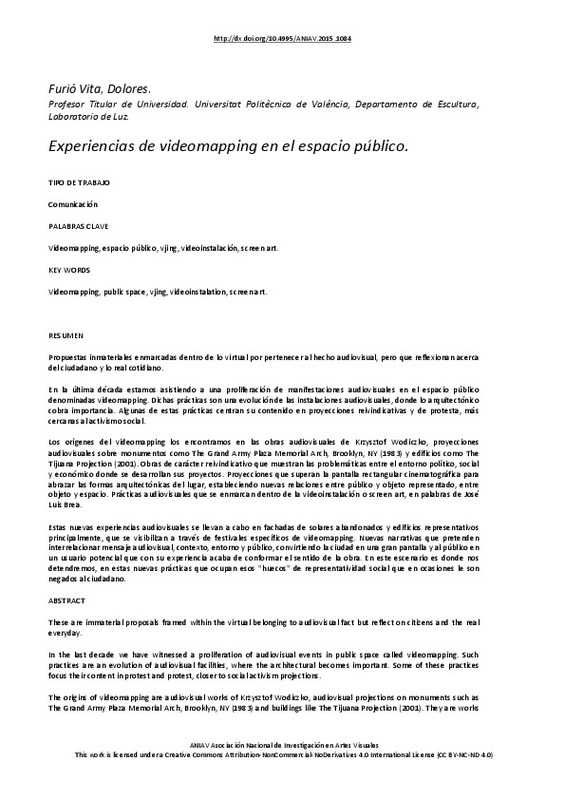JavaScript is disabled for your browser. Some features of this site may not work without it.
Buscar en RiuNet
Listar
Mi cuenta
Estadísticas
Ayuda RiuNet
Admin. UPV
Experiencias de videomapping en el espacio público
Mostrar el registro sencillo del ítem
Ficheros en el ítem
| dc.contributor.author | Furió Vita, Dolores
|
es_ES |
| dc.date.accessioned | 2018-02-13T13:14:31Z | |
| dc.date.available | 2018-02-13T13:14:31Z | |
| dc.date.issued | 2015-11-26 | |
| dc.identifier.isbn | 9788490483411 | |
| dc.identifier.uri | http://hdl.handle.net/10251/97830 | |
| dc.description.abstract | [EN] These are immaterial proposals framed within the virtual belonging to audiovisual fact but reflect on citizens and the real everyday. In the last decade we have witnessed a proliferation of audiovisual events in public space called videomapping. Such practices are an evolution of audiovisual facilities, where the architectural becomes important. Some of these practices focus their content in protest and protest, closer to social activism projections. The origins of videomapping are audiovisual works of Krzysztof Wodiczko, audiovisual projections on monuments such as The Grand Army Plaza Memorial Arch, Brooklyn, NY (19 3) and buildings like The Tijuana Projection (2001). They are works of vindicating showing the problems between the political, social and economic environment in which projects are developed. Film projections exceeding rectangular screen to embrace the architectural forms of the site, establishing new relationships between the public and represented object, between object and space. Audiovisual practices that are part of the screen video installation art or, in the words of José Luis Brea. These new audiovisual experiences are carried out on facades of representative buildings, which become visible through specific festivals videomapping. New narratives that seek to interrelate audiovisual message, context, environment and public, turning the city into a big screen and the public in a potential user whose experience just shape the meaning of the work. This stage is where we stop, in these new practices hold these "gaps" social representation that they are sometimes denied to citizens. | es_ES |
| dc.description.abstract | [ES] Propuestas inmateriales enmarcadas dentro de lo virtual por pertenecer al hecho audiovisual, pero que reflexionan acerca del ciudadano y lo real cotidiano. En la última década estamos asistiendo a una proliferación de manifestaciones audiovisuales en el espacio público denominadas videomapping. Dichas prácticas son una evolución de las instalaciones audiovisuales, donde lo arquitectónico cobra importancia. Algunas de estas prácticas centran su contenido en proyecciones reivindicativas y de protesta, más cercanas al activismo social. Los orígenes del videomapping los encontramos en las obras audiovisuales de Krzysztof Wodiczko, proyecciones audiovisuales sobre monumentos como The Grand Army Plaza Memorial Arch, Brooklyn, NY (1983) y edificios como The Tijuana Projection (2001). Obras de carácter reivindicativo que muestran las problemáticas entre el entorno político, social y económico donde se desarrollan sus proyectos. Proyecciones que superan la pantalla rectangular cinematográfica para abrazar las formas arquitectónicas del lugar, estableciendo nuevas relaciones entre público y objeto representado, entre objeto y espacio. Prácticas audiovisuales que se enmarcan dentro de la videoinstalación o screen art, en palabras de José Luis Brea. Estas nuevas experiencias audiovisuales se llevan a cabo en fachadas de solares abandonados y edificios representativos principalmente, que se visibilizan a través de festivales específicos de videomapping. Nuevas narrativas que pretenden interrelacionar mensaje audiovisual, contexto, entorno y público, convirtiendo la ciudad en una gran pantalla y al público en un usuario potencial que con su experiencia acaba de conformar el sentido de la obra. En este escenario es donde nos detendremos, en estas nuevas prácticas que ocupan esos "huecos" de representatividad social que en ocasiones le son negados al ciudadano. | es_ES |
| dc.format.extent | 4 | es_ES |
| dc.language | Español | es_ES |
| dc.publisher | Editorial Universitat Politècnica de València | es_ES |
| dc.relation.ispartof | II CONGRESO INTERNACIONAL DE INVESTIGACIÓN EN ARTE VISUALES | es_ES |
| dc.rights | Reconocimiento - No comercial - Sin obra derivada (by-nc-nd) | es_ES |
| dc.subject | Videomapping | es_ES |
| dc.subject | Espacio público | es_ES |
| dc.subject | Vjing | es_ES |
| dc.subject | Videoinstalación | es_ES |
| dc.subject | Screen art | es_ES |
| dc.subject.classification | ESCULTURA | es_ES |
| dc.title | Experiencias de videomapping en el espacio público | es_ES |
| dc.type | Capítulo de libro | es_ES |
| dc.type | Comunicación en congreso | es_ES |
| dc.identifier.doi | 10.4995/ANIAV.2015.1084 | |
| dc.rights.accessRights | Abierto | es_ES |
| dc.contributor.affiliation | Universitat Politècnica de València. Departamento de Escultura - Departament d'Escultura | es_ES |
| dc.contributor.affiliation | Universitat Politècnica de València. Facultad de Bellas Artes - Facultat de Belles Arts | es_ES |
| dc.description.bibliographicCitation | Furió Vita, D. (2015). Experiencias de videomapping en el espacio público. En II CONGRESO INTERNACIONAL DE INVESTIGACIÓN EN ARTE VISUALES. Editorial Universitat Politècnica de València. 271-274. https://doi.org/10.4995/ANIAV.2015.1084 | es_ES |
| dc.description.accrualMethod | OCS | es_ES |
| dc.relation.conferencename | II Congreso Internacional de Investigación en Artes Visuales. |< real | virtual >| ANIAV2015 | es_ES |
| dc.relation.conferencedate | July 09-10,2015 | es_ES |
| dc.relation.conferenceplace | Valencia, Spain | es_ES |
| dc.relation.publisherversion | http://ocs.editorial.upv.es/index.php/ANIAV/ANIAV2015/paper/view/1084 | es_ES |
| dc.description.upvformatpinicio | 271 | es_ES |
| dc.description.upvformatpfin | 274 | es_ES |
| dc.type.version | info:eu-repo/semantics/publishedVersion | es_ES |
| dc.relation.pasarela | OCS\1084 | es_ES |








